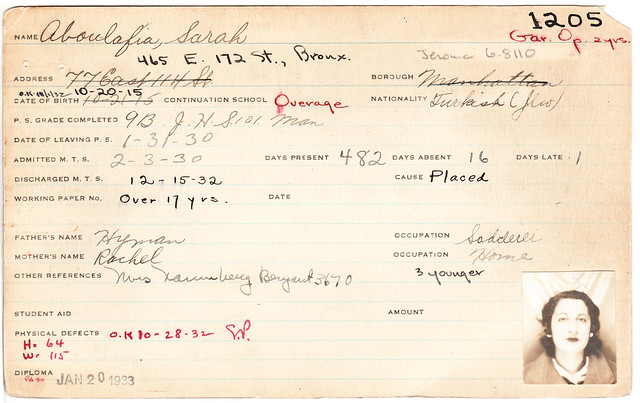
As I mentioned in an earlier post, the Manhattan Trade School for Girls had a job placement office that helped the students find work after they graduated. When a student was placed in a new job, she was given postage-paid postcard, which she was expected fill out with a description of her experiences at the job and then mail back to the placement office. The information on the postcard was then transferred to a beige card in the student's permanent file.
Those beige cards had extremely small boxes, which forced the placement office's staff to execute some extraordinary handwriting. In the case of Sarah Aboulafia, whose main report card is shown above, the data on the beige card is a model of teeny-tiny space-efficiency. That image shows the card at its actual size (5" x 8"); here's a larger view, so you can actually read what was written.
There's something very physical -- almost textural or tactile -- about this handwriting. It was done with a fountain pen, but there are no smudges, no ink splotches. No cross-outs, either. In fact, there are only two or three cross-outs in my entire collection of Manhattan Trade report cards, which really speaks to the quality of penmanship during the early 1900s (or maybe just to the incredible level of schoolmarm-ish perfectionism among the school's staff).
A few notes about the information on Sarah's beige card:
• In the "Firm" column, it's amazing to see how they managed to squeeze in the address for each company Sarah worked for. None of those businesses still exists today (unsurprising, since the Manhattan garment trade is now a bare sliver of what it was in the early 1930s).
• The "Business" column shows all the different types of products Sarah worked on: men's neckwear (i.e., ties), nurses' uniforms, curtains, bedspreads, hats, underwear, capes (I love that it specifies evening capes), corsets, and abdominal belts (I think this means trusses).
• In the "Kind of Work" column, "Singer op" means Sarah was doing garment work on a Singer sewing machine. This is what she'd been trained in -- if you go back and look at her main report card at the top of this blog post, you'll see "Gar Op" in the top-right corner, which means her chosen trade was sewing machine operation. (Other choices offered by the school included dressmaking, millinery, lampshade making, etc.)
• As you can see, Sarah's weekly wages more than doubled in the span of about a year and a half -- a testament to the skills she learned at Manhattan Trade.
• In the "How Found" column, "MIHS" refers to Manhattan Industrial High School, which is what Manhattan Trade renamed itself in 1930. (It would change names two additional times in the next 15 years or so. But for the purposes of this project, I've continued to refer to its as the Manhattan Trade School for Girls, because it's less confusing for everyone if I stick to one name.)
• In the "Reason for Leaving" column, "Slack" does not mean Sarah was a slacker. It refers to a business's slack season -- the slow period in a seasonal or cyclical industry.
Amazing stuff, no? I don't know who filled out this card, but let's all give a silent thanks for her remarkable handwriting, which allows us to glean so much information nearly 80 years after the fact.

for nationality it says Turkish, but I cannot decipher what is next to it in parentheses. Jlco?
ReplyDelete"(Jew)"
ReplyDeleteWhat I find most interesting is the last entry, at bottom right, where it says she was not employed from January until July 1936 because of a nervous breakdown. I'd love to know more of this story...
ReplyDeleteBeautiful! Who wouldn't love to find one of their relatives in this collection? Wow, the information from name, nationality, date of birth, addresses, work history- Too bad I don't have relatives from New York!
ReplyDelete